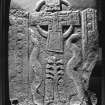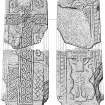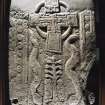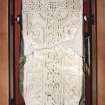Following the launch of trove.scot in February 2025 we are now planning the retiral of some of our webservices. Canmore will be switched off on 24th June 2025. Information about the closure can be found on the HES website: Retiral of HES web services | Historic Environment Scotland
Farnell, Parish Church And Burial-ground
Cross Slab (Early Medieval)
Site Name Farnell, Parish Church And Burial-ground
Classification Cross Slab (Early Medieval)
Alternative Name(s) Farnell Graveyard; Farnell Parish Kirk
Canmore ID 318046
Site Number NO65NW 23.01
NGR NO 62738 55425
NGR Description Centred at NO 62738 55425
Datum OSGB36 - NGR
Permalink http://canmore.org.uk/site/318046
- Council Angus
- Parish Farnell
- Former Region Tayside
- Former District Angus
- Former County Angus
Farnell, Angus, Pictish cross-slab
Measurements: H 2.04m, W 0.72m
Stone type: Old Red Sandstone
Place of discovery: NO 6273 5542
Present location: Meffan Museum, Forfar ?
Evidence for discovery: found in Farnell churchyard in 1849 and placed in the porch at Kinnaird Castle. It was then donated by the Earl of Southesk to Montrose Museum in 1865.
Present condition: worn, damaged and broken into two with missing portions.
Description
Once an imposing slab, these two fragments show that it is carved in relief on both broad faces and that the top is shaped into a pediment. On face A the cross extends almost the full length of the slab and its side-arms the full width of the slab. The arm terminals are rectangular and there is a central square and a ring linking the arms. The entire cross is filled with three-cord interlace within a roll moulding, and the ring with simple key pattern. On this face the border of the slab takes the form of a flatband moulding with two incised median lines, but the apex is too damaged to see whether it was embellished. Either side of the upper arm of the cross there is zoomorphic interlace, while flanking the shaft are two panels on either side, the upper two containing non-identical zoomorphic motifs and the lower two filled with key pattern on the left and simple fat interlaced strands.
The upper part of face C has a large area where the carving has flaked off, but its general character is clear. The sides of the slab have a wide frame consisting of double roll mouldings with a median strip of flat pellets, which towards the top of the slab becomes the bodies of two animals each with a foreleg and at the apex an open-jawed head with fangs, large round eye and pointed ear. Their heads confront one another and their symmetrical forelegs just touch the head of the large frontal angel below. Beneath the angel is a ringed cross with an inner incised cross and squared terminals. Beneath cross is an apple tree with Adam and Eve on either side, Eve holding an apple and Adam a shepherd’s crook. They are flanked on either side by a very large serpent, head downwards with protruding eyes.
Date range: ninth or tenth century.
Primary references: Chalmers 1848, pl 21; ECMS, iii, 219-21; RCAHMS 2003.
Compiled by A Ritchie 2016
Farnell, Angus, Pictish cross-slab
Measurements: H 2.04m, W 0.72m
Stone type: Old Red Sandstone
Place of discovery: NO 6273 5542
Present location: Meffan Museum, Forfar
Evidence for discovery: found in Farnell churchyard in 1849 and placed in the porch at Kinnaird Castle. It was then donated by the Earl of Southesk to Montrose Museum in 1865.
Present condition: worn, damaged and broken into two with missing portions.
Description
Once an imposing slab, these two fragments show that it is carved in relief on both broad faces and that the top is shaped into a pediment. On face A the cross extends almost the full length of the slab and its side-arms the full width of the slab. The arm terminals are rectangular and there is a central square and a ring linking the arms. The entire cross is filled with three-cord interlace within a roll moulding, and the ring with simple key pattern. On this face the border of the slab takes the form of a flat-band moulding with two incised median lines, but the apex is too damaged to see whether it was embellished. Either side of the upper arm of the cross there is zoomorphic interlace, while flanking the shaft are two panels on either side, the upper two containing non-identical zoomorphic motifs and the lower two filled with key pattern on the left and simple fat interlaced strands.
The upper part of face C has a large area where the carving has flaked off, but its general character is clear. The sides of the slab have a wide frame consisting of double roll mouldings with a median strip of flat pellets, which towards the top of the slab becomes the bodies of two animals each with a foreleg and at the apex an open-jawed head with fangs, large round eye and pointed ear. Their heads confront one another and their symmetrical forelegs just touch the head of the large frontal angel below. Beneath the angel is a ringed cross with an inner incised cross and squared terminals. Beneath cross is an apple tree with Adam and Eve on either side, Eve holding an apple and Adam a shepherd’s crook. They are flanked on either side by a very large serpent, head downwards with protruding eyes.
Date range: ninth or tenth century.
Primary references: Chalmers 1848, pl 21; ECMS pt 3, 219-21; RCAHMS 2003.
Desk-based information compiled by A Ritchie 2018
Field Visit (1980)
The symbol-bearing slab of old red sandstone measures 2.05m x 6.9m (maximum width). It is roughly rectangular in shape with a pedimented top and is ornamented in relief on two faces. The front bears a Celtic cross containing interlaced panels and zoomorphic interlacing also. The back shows the temptation of Adam and Eve, the figure of an angel, 2 attenuated monsters and a cross, all encased within a 'jewelled' margin. The stone is entirely broken across on the reverse side and is clamped with a support.
Visited by R Jones 1980.
Note (1983)
Farnell NO 627 554 NO65NW 23
In 1849 a Class II Pictish cross-slab was discovered 'in the line of the foundation' of the old church in Farnell burial-ground.
RCAHMS 1983
(Jervise 1857a; 197; Warden 1880-85, iii, 243; Allen and Anderson 1903, iii, 219-21; Eeles 1910, 356-8).




























